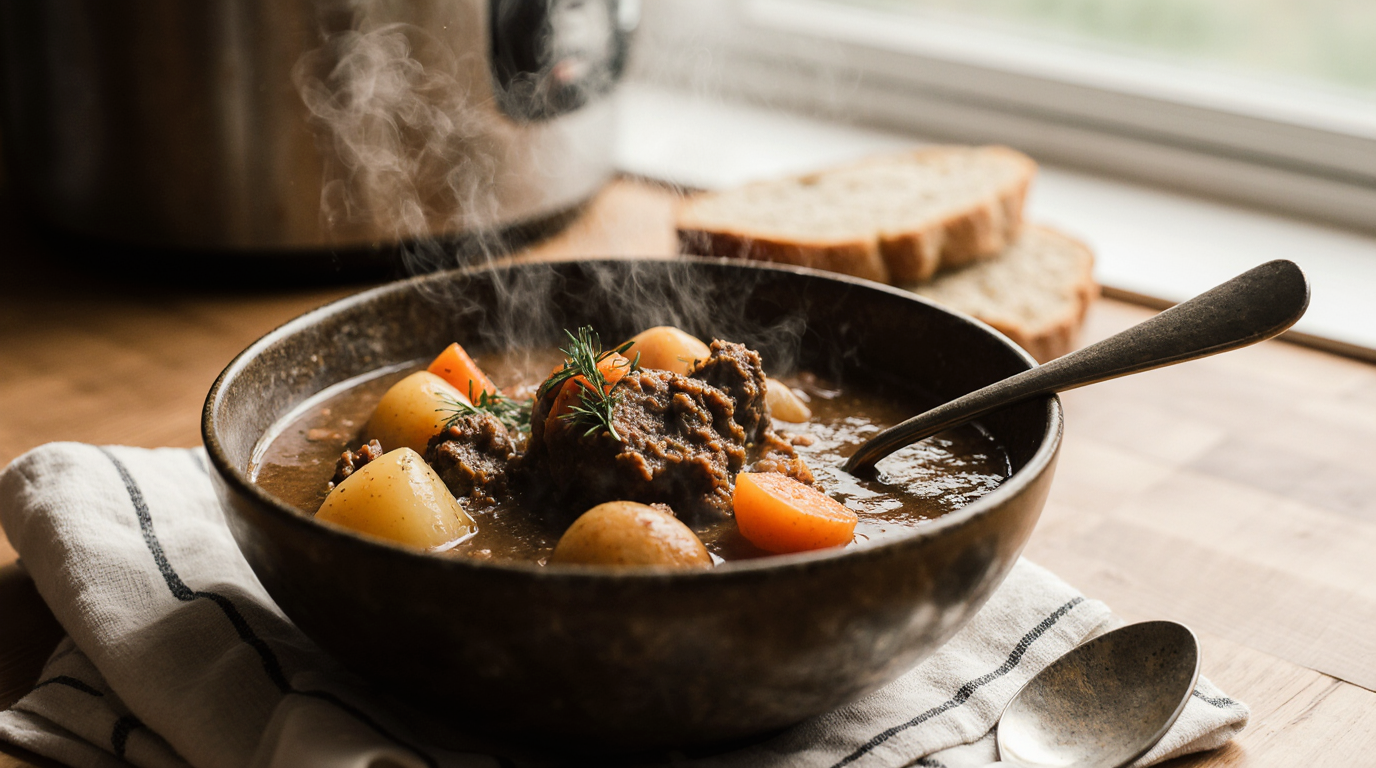Slow Cooker Beef Stew – Tender, Hearty & Easy Comfort Food Recipe
As the weather cools down, you’re likely craving a hearty, comforting meal that’s easy to prepare. Look no further than a delicious beef stew made to perfection in your slow cooker. This recipe is a game-changer for a busy day when you want a nutritious meal ready as soon as you walk in the door.
This tender and flavorful dish is a perfect example of a comfort food recipe that warms your heart and satisfies your appetite. With minimal preparation and the convenience of a slow cooker, you can enjoy a homemade stew without the fuss.
Key Takeaways
- Easy to prepare with minimal ingredients
- Perfect for a busy day with a ready-to-eat meal
- Tender and flavorful beef in a rich stew
- A great comfort food recipe for cold weather
- Utilizes the convenience of a slow cooker
The Magic of Slow Cooker Beef Stew
There’s something undeniably comforting about a warm, hearty bowl of Slow Cooker Beef Stew on a chilly evening. You can almost smell the aroma of tender beef and vegetables simmered in a rich broth, filling your home with warmth and comfort.
Why Beef Stew Is the Ultimate Comfort Food
Beef stew has long been a staple of comfort cuisine, providing a sense of warmth and nourishment. It’s a dish that not only satisfies your hunger but also offers a feeling of being cared for.
Nutritional Benefits of a Hearty Stew
A well-made beef stew is not just comforting; it’s also packed with nutrients. The slow cooking process breaks down the connective tissues in the meat, making it tender and easily digestible. You also get a serving of vegetables, which are rich in vitamins and minerals. For instance, carrots are high in vitamin A, while potatoes provide a good source of potassium.
| Nutrient | Benefit |
|---|---|
| Vitamin A | Supports healthy vision and immune function |
| Potassium | Helps regulate blood pressure |
Historical Significance of Beef Stew
Beef stew has a rich history that spans across various cultures. It’s a dish that has been enjoyed for centuries, with its origins tracing back to medieval Europe. The simplicity and heartiness of stew made it a staple for many communities.
“Stew is a dish that’s as old as the hills, and just as comforting.” –
Anonymous Chef
Benefits of Using a Slow Cooker for Stews
Using a slow cooker for your beef stew offers several advantages. It allows for the tenderization of tougher cuts of meat, making them palatable and delicious. The slow cooking process also enhances the flavors, creating a rich and savory broth.
Energy Efficiency and Convenience
Slow cookers are designed to be energy-efficient, using less power than traditional cooking methods. They’re also incredibly convenient, allowing you to prepare your ingredients in the morning and come home to a ready-to-eat meal.
Flavor Development Through Slow Cooking
The slow cooking process is key to developing the deep, complex flavors associated with a great beef stew. As the ingredients simmer together, they release their flavors into the broth, creating a dish that’s both hearty and satisfying.
- Tenderizes tougher cuts of meat
- Enhances flavor development
- Convenient and energy-efficient
Essential Ingredients for Perfect Slow Cooker Beef Stew
A great slow cooker beef stew recipe hinges on the ingredients you choose. The right combination of beef, vegetables, and seasonings can elevate this comfort food to new heights.
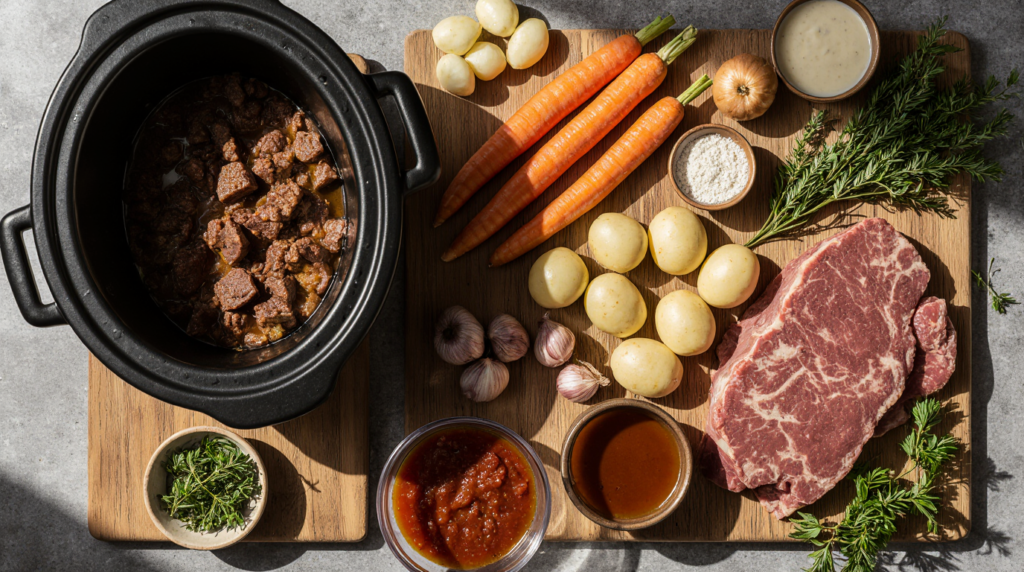
Selecting the Best Cuts of Beef for Stewing
Choosing the right cut of beef is crucial for a tender and flavorful stew. Chuck roast and stew meat are popular choices, but they have some differences.
Chuck Roast vs. Stew Meat
Chuck roast is a larger cut that requires more preparation, while stew meat is pre-cut into smaller pieces. Both can produce excellent results, depending on your preference.
Importance of Marbling and Connective Tissue
Beef cuts with good marbling and connective tissue, like chuck roast, become tender and flavorful after slow cooking. This is because the connective tissues break down, enriching the stew.
Vegetables That Hold Up Well in Slow Cooking
Root vegetables are ideal for slow cooker beef stew as they retain their texture and flavor.
Root Vegetables and Their Cooking Properties
Carrots, potatoes, and parsnips are excellent choices. They cook slowly and absorb the flavors of the stew.
When to Add Delicate Vegetables
Vegetables like peas and spinach should be added towards the end of cooking to preserve their texture and color.
Herbs and Seasonings for Maximum Flavor
The right herbs and spices can significantly enhance the flavor of your stew. Thyme and rosemary are classic choices that complement beef well.
Fresh vs. Dried Herbs in Slow Cooking
Dried herbs are more convenient for slow cooking as they retain their flavor over long periods. However, fresh herbs can be added towards the end for a brighter flavor.
Building a Flavor Profile with Spices
Spices like paprika and bay leaves add depth to the stew. Experimenting with different spice combinations can help you create a unique flavor profile.
Equipment Needed for Slow Cooker Beef Stew
The key to a perfect slow cooker beef stew lies in the equipment you use, from the slow cooker itself to the utensils for preparation. Having the right tools not only makes the cooking process smoother but also ensures that your stew turns out tender and flavorful.
Choosing the Right Slow Cooker Size and Type
When it comes to slow cookers, size and type matter. You’ll want to choose a slow cooker that’s large enough to hold all your ingredients comfortably. For a typical beef stew recipe, a 6-quart slow cooker is usually sufficient.
Programmable vs. Manual Slow Cookers
Programmable slow cookers offer the convenience of setting a timer, so your stew can cook while you’re away. Manual slow cookers, on the other hand, require you to turn them on and off manually. Both types can produce excellent results, so it comes down to personal preference.
Material Considerations (Ceramic vs. Metal)
Slow cookers come with either ceramic or metal inserts. Ceramic inserts are great for even heating and are often preferred for their non-reactive properties. Metal inserts, particularly those made from stainless steel, are durable and can be used at higher temperatures.
Additional Kitchen Tools for Preparation
Apart from the slow cooker, you’ll need a few other kitchen tools to prepare your beef stew. These include knives and cutting boards for chopping vegetables and meat.
Knives and Cutting Boards for Meat Preparation
A sharp knife and a sturdy cutting board are essential for preparing your ingredients. Look for a knife with a comfortable grip and a cutting board that’s easy to clean.
Optional Tools That Make the Process Easier
While not necessary, tools like a meat thermometer and a ladle can make the cooking process easier and more efficient. A meat thermometer ensures your beef is cooked to a safe temperature, and a ladle helps with serving.
Preparation Steps Before Slow Cooking
Getting your ingredients ready is an essential part of the slow cooker beef stew process. Proper preparation ensures that your stew is not only delicious but also safe to eat. In this section, we’ll walk you through the necessary steps to prepare your beef and vegetables for slow cooking.
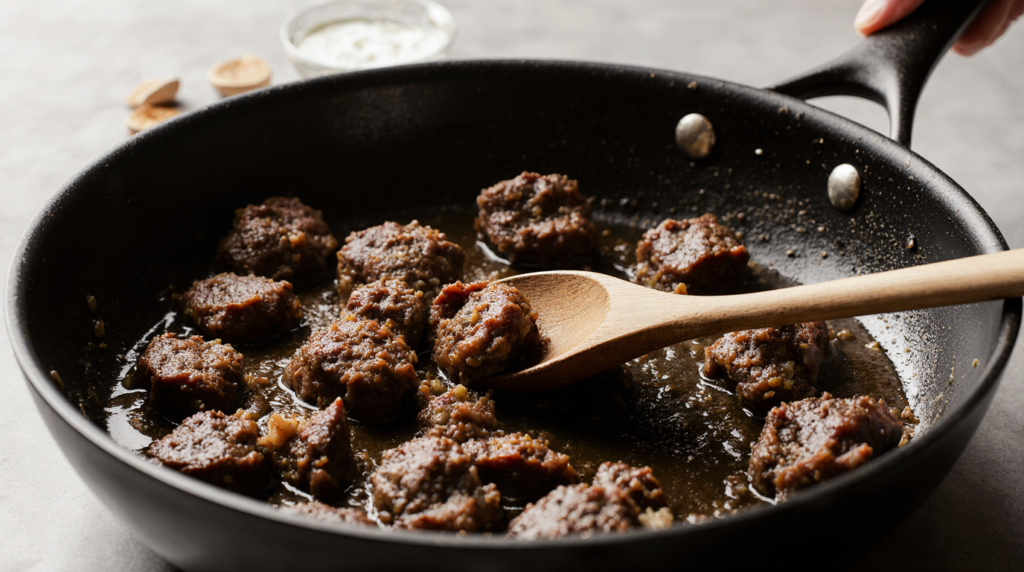
Properly Cutting and Preparing the Beef
Preparing the beef correctly is crucial for a tender and flavorful stew. This involves two main steps: trimming the fat and cutting the beef into uniform pieces.
Trimming Fat and Cutting Uniform Pieces
Start by trimming any excess fat from the beef. This helps prevent the stew from becoming too greasy. Then, cut the beef into uniform pieces, about 1-2 inches in size. Uniform pieces ensure that the beef cooks evenly throughout the stew.
Seasoning and Dredging Techniques
Season the beef pieces with salt, pepper, and your choice of herbs. You can also dredge the beef in flour to create a richer flavor and thicker stew. This step adds depth to your stew and helps to create a satisfying texture.
Vegetable Preparation Techniques
Preparing your vegetables correctly is just as important as preparing the beef. The key is to ensure they are cut into appropriate sizes and shapes for even cooking.
Size and Shape Considerations for Even Cooking
Cut your vegetables into uniform sizes so that they cook at the same rate. For example, chop carrots and potatoes into bite-sized pieces.
Pre-cooking Certain Vegetables
Some vegetables, like mushrooms, may benefit from a quick sauté before being added to the slow cooker. This step can enhance their flavor and texture.
The Importance of Browning Meat Before Slow Cooking
Browning the meat before slow cooking is a crucial step that enhances the flavor of your stew. This process is known as the Maillard reaction.
Maillard Reaction and Flavor Development
The Maillard reaction occurs when amino acids and reducing sugars react with heat, resulting in a rich, complex flavor. This reaction is the foundation of many savory dishes, including beef stew.
Deglazing the Pan for Maximum Flavor
After browning the meat, deglaze the pan with a bit of wine or broth to capture all the flavorful browned bits. This liquid then adds depth to your stew.
Classic Slow Cooker Beef Stew Recipe
Our Classic Slow Cooker Beef Stew Recipe is a timeless comfort food dish that’s sure to become a family favorite. This hearty stew is made with tender chunks of beef, fresh vegetables, and a rich broth, all slow-cooked to perfection in your crock pot.
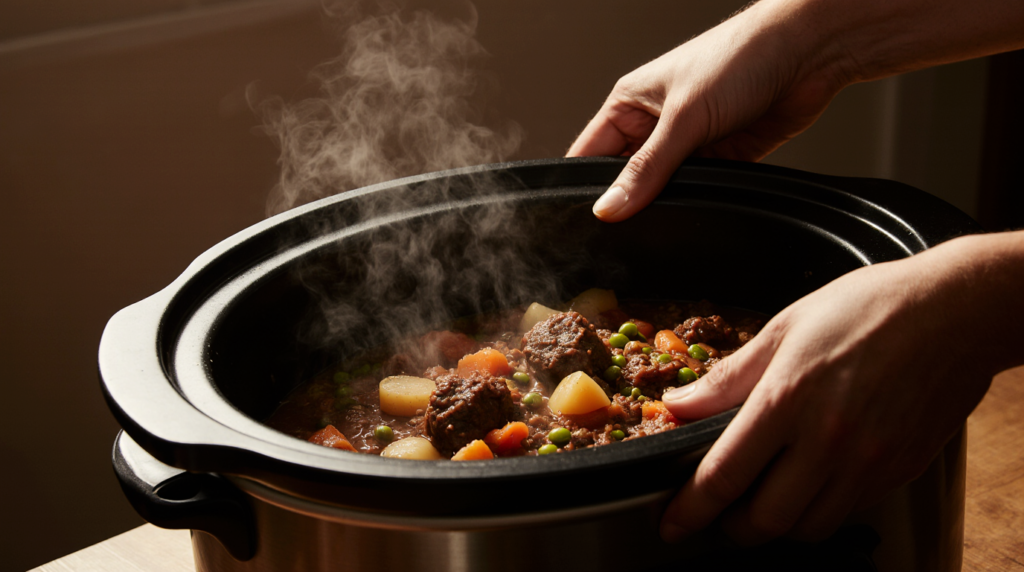
Ingredient List with Measurements
To make this delicious homemade beef stew, you’ll need the following ingredients:
Meat and Vegetables
- 2 pounds beef stew meat (chuck or round)
- 3 medium-sized potatoes, peeled and cubed
- 2 large carrots, peeled and sliced
- 1 large onion, chopped
- 3 cloves garlic, minced
Liquids and Seasonings
- 2 cups beef broth
- 1 cup water
- 1 tablespoon tomato paste
- 1 teaspoon dried thyme
- Salt and pepper, to taste
Step-by-Step Cooking Instructions
Follow these easy steps to prepare your crock pot beef stew recipes slow cooker:
Preparation Phase
Start by seasoning the beef with salt and pepper. Then, heat a skillet over medium-high heat and brown the beef on all sides. This step enhances the flavor of your stew. Once browned, transfer the beef to your slow cooker. Add the chopped onion, minced garlic, potatoes, and carrots.
Slow Cooking Process
Pour in the beef broth, water, and tomato paste. Stir well to combine, then add the thyme. Cover the slow cooker and cook on low for 8-10 hours or on high for 4-6 hours.
Timing and Temperature Guidelines
The key to a tender beef stew is cooking it low and slow. Here are some guidelines to ensure your stew turns out perfectly:
Low vs. High Heat Settings
Cooking on low heat for 8-10 hours is ideal for tenderizing the beef, while cooking on high heat for 4-6 hours is better for those with less time. Adjust the cooking time based on your slow cooker’s specifications.
How to Tell When Your Stew Is Done
The stew is done when the beef is tender and the vegetables are cooked through. You can check for doneness by inserting a fork into the beef; if it slides in easily, the stew is ready.
Tips for Enhancing Your Slow Cooker Beef Stew
Transform your slow cooker beef stew into a culinary masterpiece by incorporating a few clever strategies that boost flavor and texture. Whether you’re looking to thicken the stew, add ingredients at the right time, or enhance the overall flavor, these tips will guide you.
How to Thicken the Stew Properly
A thick, hearty stew is a hallmark of a well-cooked slow cooker beef stew. There are several methods to achieve the desired consistency.
Flour and Cornstarch Methods
Mixing flour or cornstarch with a small amount of water or broth before adding it to the stew can effectively thicken the stew. Use 1 tablespoon of flour or cornstarch per cup of liquid. Stir well to avoid lumps.
Reduction Techniques
Another method is to remove the lid of the slow cooker for the last 30 minutes to 1 hour of cooking, allowing some of the liquid to evaporate and the stew to thicken naturally.
Adding Ingredients at the Right Time
The timing of adding ingredients can significantly impact the final result. Layering ingredients and making late additions can enhance the overall quality of the stew.
Layering Ingredients for Optimal Cooking
Start with a layer of aromatics like onions, followed by the beef, and then the vegetables. This order ensures that the flavors meld together properly.
Late Additions for Freshness and Texture
Adding fresh herbs or delicate vegetables towards the end of cooking preserves their texture and flavor. Consider adding peas or chopped fresh parsley in the last 30 minutes.
Flavor-Boosting Techniques
Enhancing the flavor of your slow cooker beef stew can be achieved through various techniques, including the use of umami enhancers and balancing acidity.
Umami Enhancers
Ingredients like tomato paste and Worcestershire sauce are rich in umami flavor. Add 1-2 tablespoons of tomato paste or 1 teaspoon of Worcestershire sauce to significantly enhance the depth of flavor.
Acid Balance
A splash of red wine or a tablespoon of vinegar can balance the richness of the stew. This contrast in flavors elevates the overall taste experience.
| Technique | Description | Benefit |
|---|---|---|
| Flour/Cornstarch | Mix with water/broth before adding | Effective thickening |
| Reduction | Remove lid for last 30-60 minutes | Natural thickening |
| Layering | Start with aromatics, then beef, then vegetables | Optimal flavor melding |
| Late Additions | Add fresh herbs/vegetables towards the end | Preserves texture and flavor |
| Umami Enhancers | Add tomato paste or Worcestershire sauce | Deepens flavor |
| Acid Balance | Add red wine or vinegar | Balances richness |
Storing and Reheating Your Beef Stew
Proper storage and reheating are crucial for maintaining the flavor and texture of your homemade beef stew. After cooking, it’s essential to handle the stew correctly to preserve its quality.
Proper Cooling and Storage Methods
Cooling your stew quickly is vital to prevent bacterial growth. You can speed up the cooling process by dividing the stew into smaller portions or using an ice bath.
Refrigeration Guidelines
Once cooled, your stew can be stored in the refrigerator for up to 3-4 days. Ensure it’s kept in airtight containers to maintain freshness.
Freezing Techniques for Long-term Storage
For longer storage, consider freezing your stew. Use airtight, freezer-safe containers or freezer bags, and label them with the date. Your stew meat crock pot creations can be frozen for up to 3 months.
Reheating for Best Flavor and Texture
Reheating your stew correctly is just as important as storing it properly. The method you choose can affect the final texture and flavor.
Stovetop Reheating Methods
Reheating on the stovetop allows for even heating and the ability to stir the stew. Heat it over low heat, stirring occasionally, until it’s warmed through.
Microwave Tips for Single Servings
For individual servings, the microwave is a quick option. Use a microwave-safe container, cover it, and heat on medium power, checking and stirring every 30 seconds until hot.
How Stew Flavors Develop Over Time
Many find that stew tastes better the next day. This is because the flavors have melded together during refrigeration.
The Science Behind “Better the Next Day”
The resting time allows the flavors to integrate and intensify, making the stew more delicious.
Refreshing Leftover Stew
If your stew seems a bit thick or bland after refrigeration, you can refresh it by adding a bit of broth or seasoning. This can revive the flavors and texture.
Serving and Pairing Suggestions
Serving slow cooker beef stew is an art that involves choosing the perfect sides and beverages to complement its rich flavors. You can elevate this comforting dish to a whole new level with the right accompaniments.
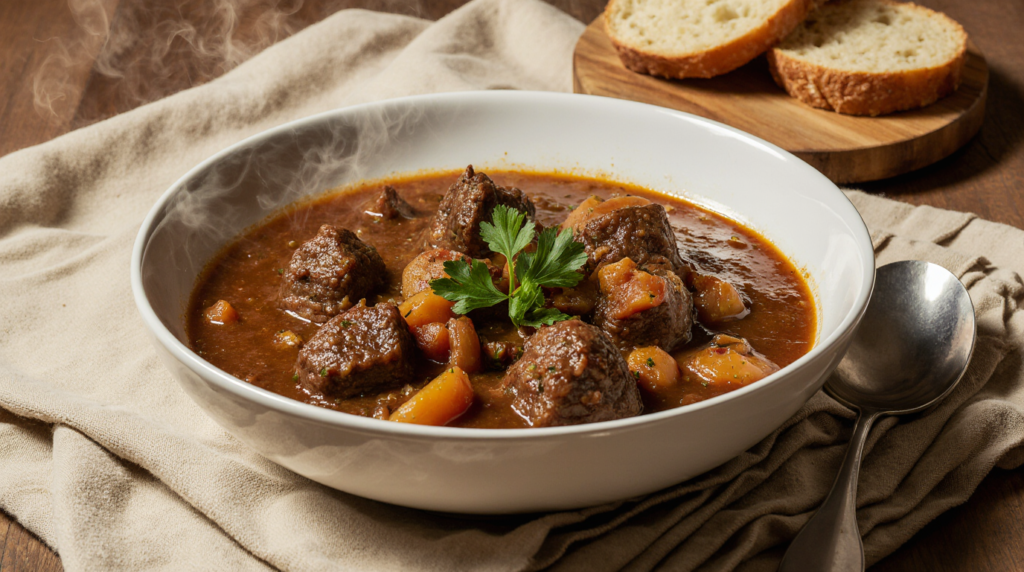
Best Side Dishes to Accompany Beef Stew
When it comes to side dishes, there are several options that pair well with slow cooker beef stew. You can choose between various bread options or simple sides that complement without overwhelming the palate.
Bread Options
Crusty bread, cornbread, and biscuits are excellent choices to serve alongside your beef stew. Crusty bread is perfect for dipping into the stew’s savory broth, while cornbread adds a delightful sweetness. Biscuits, on the other hand, provide a comforting, homey feel to the meal.
Simple Sides That Complement Without Overwhelming
Simple sides like a green salad, roasted vegetables, or mashed potatoes can complement the stew without overwhelming it. These options allow you to balance the meal and cater to different tastes.
Wine and Beverage Pairings
The right beverage can enhance the flavors of your slow cooker beef stew. Whether you prefer wine or a non-alcoholic drink, there are several options to consider.
Red Wine Selections
A robust red wine like Cabernet Sauvignon or Merlot pairs well with the rich flavors of beef stew. The tannins in these wines complement the bold flavors of the dish.
Non-alcoholic Pairing Options
If you prefer a non-alcoholic beverage, consider serving your stew with a glass of iced tea or a refreshing lemonade. For a more adult-oriented gathering, a sparkling water with a twist of lemon or a flavored seltzer can cleanse the palate between bites.
Presentation Ideas for Different Occasions
How you present your slow cooker beef stew can vary depending on the occasion. Whether you’re serving a family dinner or hosting guests, there are presentation ideas to suit every need.
Family-Style Serving
For a family dinner, serving the stew family-style in a large, communal dish encourages sharing and togetherness.
Individual Plating for Guests
When hosting guests, consider serving the stew in individual bowls. You can garnish each bowl with fresh herbs for a touch of elegance.
| Occasion | Side Dish | Beverage Pairing | Presentation Style |
|---|---|---|---|
| Family Dinner | Crusty Bread | Iced Tea | Family-Style |
| Guest Dinner | Mashed Potatoes | Red Wine | Individual Plating |
| Casual Gathering | Green Salad | Lemonade | Family-Style |
Conclusion
As you’ve discovered, creating a delicious homemade beef stew using a slow cooker is a straightforward process that yields tender, flavorful results. By following the steps outlined in this article, you can enjoy a hearty slow cooker beef stew that’s perfect for any occasion.
The beauty of this recipe lies in its simplicity and versatility. You can easily customize it to suit your taste preferences by adding your favorite vegetables or adjusting the seasonings. The slow cooker does the hard work for you, allowing you to come home to a warm, comforting meal.
Whether you’re a busy professional or an avid home cook, incorporating slow cooker beef stew into your meal rotation is a great way to enjoy a satisfying, homemade meal with minimal effort. So why not give it a try? Experiment with different ingredients, explore the tips and techniques provided, and make this comforting dish a staple in your kitchen.
FAQ
What is the best cut of beef to use for slow cooker beef stew?
The best cuts of beef for slow cooker beef stew are chuck roast and stew meat, as they become tender with slow cooking. Chuck roast is particularly recommended due to its marbling and connective tissue, which enhance flavor and texture.
Can I use frozen beef for slow cooker beef stew?
While it’s technically possible to use frozen beef, it’s recommended to thaw it first for even cooking and food safety. If you must use frozen beef, ensure it’s cooked on low for an additional hour or until it reaches a safe internal temperature.
How do I thicken my slow cooker beef stew?
You can thicken your slow cooker beef stew by mixing flour or cornstarch with a little water or broth to create a slurry, then stirring it into the stew. Alternatively, you can reduce the stew’s liquid by cooking it on high with the lid off for a short period.
Can I add potatoes to my slow cooker beef stew?
Yes, potatoes are a great addition to slow cooker beef stew. They hold up well to slow cooking and add natural sweetness. For best results, cut them into uniform pieces and add them during the last few hours of cooking to prevent overcooking.
How long can I store leftover slow cooker beef stew?
Leftover slow cooker beef stew can be stored in the refrigerator for up to 3-4 days or frozen for up to 3 months. When reheating, make sure it reaches a safe internal temperature to prevent foodborne illness.
Can I make slow cooker beef stew in advance?
Yes, you can prepare the ingredients for slow cooker beef stew in advance, such as chopping vegetables and browning the meat, then refrigerate or freeze them until you’re ready to cook.
What are some common mistakes to avoid when making slow cooker beef stew?
Common mistakes to avoid include not browning the meat before slow cooking, not adjusting the seasoning, overcooking or undercooking the stew, and not layering ingredients correctly. Being mindful of these factors can help you achieve a rich, flavorful stew.
Leave a Review & Rate This Recipe!
There are no reviews yet. Be the first one to write one.

